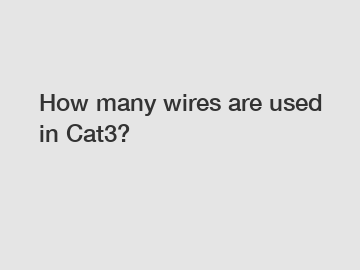How many wires are used in Cat3?
How many wires are used in Cat3?
When it comes to network cabling, it is essential to understand the different types of cables and their specifications. One such cable is Cat3, which was widely used in the past for telephone wiring. Cat3 cables have specific characteristics that make them suitable for telephone systems, but are they still relevant in today's world of high-speed internet? One crucial aspect to consider is the number of wires used in Cat3 cables. In this article, we will explore the question of how many wires are used in Cat3 and provide an overview of its applications.
Overview of Cat3 Cables.

Before diving into the number of wires, it is important to have a basic understanding of Cat3 cables. Cat3, short for Category 3, is an unshielded twisted pair (UTP) cable that consists of four pairs of copper wires. Each pair is color-coded, usually in blue, orange, green, and brown. The wires are twisted together to reduce electromagnetic interference and improve signal transmission.
Primary Function of Cat3 Cables.
Cat3 cables were primarily used for telephone systems in the past. They were capable of carrying voice signals over short distances, typically within buildings or homes. However, their transmission capabilities were limited to a maximum frequency of 16 MHz, making them unsuitable for high-speed internet or other data-intensive applications.
Number of Wires Used in Cat3.
As mentioned earlier, Cat3 cables contain four pairs of wires. Each pair consists of two individual wires, making a total of eight wires within the cable. These wires are used for transmitting and receiving signals in telecommunication applications. However, it is worth noting that only two of the eight wires are typically used for basic telephone systems, where one wire carries the incoming signals and the other carries outgoing signals.
Cat3 vs. Cat5e and Cat6.
With the advancement of technology and the increasing demand for faster internet speeds, Cat3 cables have become outdated for data transmission purposes. Cat5e and Cat6 cables are now the preferred choices for network installations. Cat5e cables contain four pairs of wires, just like Cat3, but they have higher transmission capabilities. They can support frequencies up to 100 MHz and are suitable for Ethernet connections.
On the other hand, Cat6 cables, also consisting of four pairs of wires, offer even higher performance. They can transmit signals at frequencies up to 250 MHz and are designed for Gigabit Ethernet networks. Cat6 cables also have stricter specifications for crosstalk and system noise compared to Cat5e, ensuring better signal quality.
Conclusion.
In summary, Cat3 cables contain a total of eight wires, with four pairs of twisted copper wires. Although they were widely used for telephone systems in the past, their limited transmission capabilities make them less relevant for modern communication needs. Cat5e and Cat6 cables have surpassed Cat3 in terms of data transmission capabilities, and they are now the preferred choices for network installations.
If you have any further questions about Cat3 cables or require assistance with network cabling, feel free to contact us. Our team of experts will be more than happy to help you with your networking needs.
Are you interested in learning more about twisted speaker cable, Copper Cable Supplier, Copper Cable Accessories? Contact us today to secure an expert consultation!

Comments